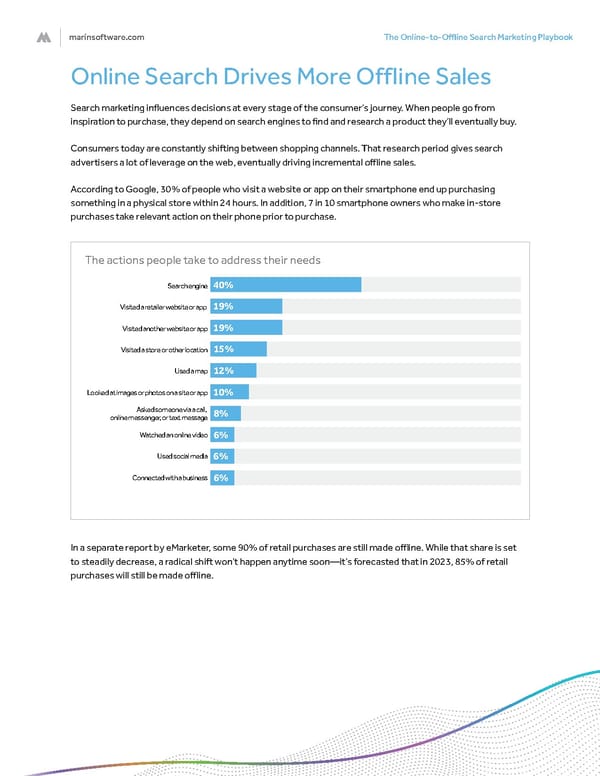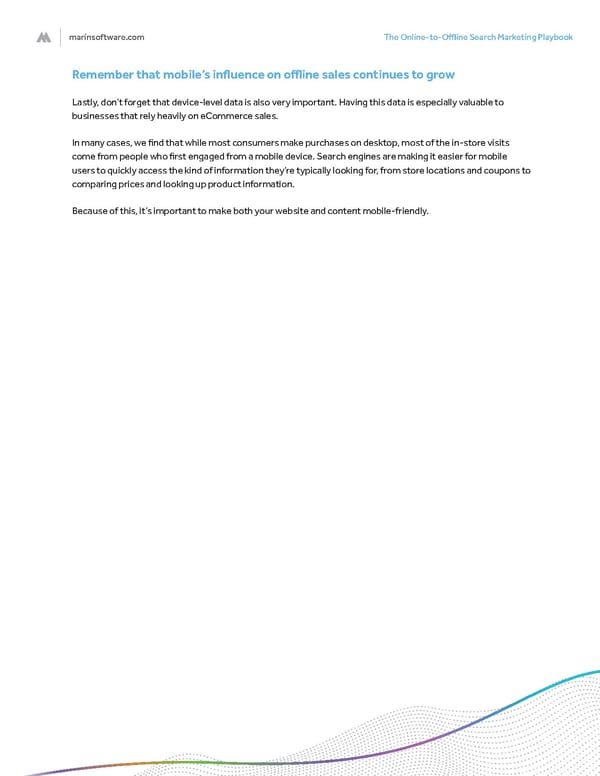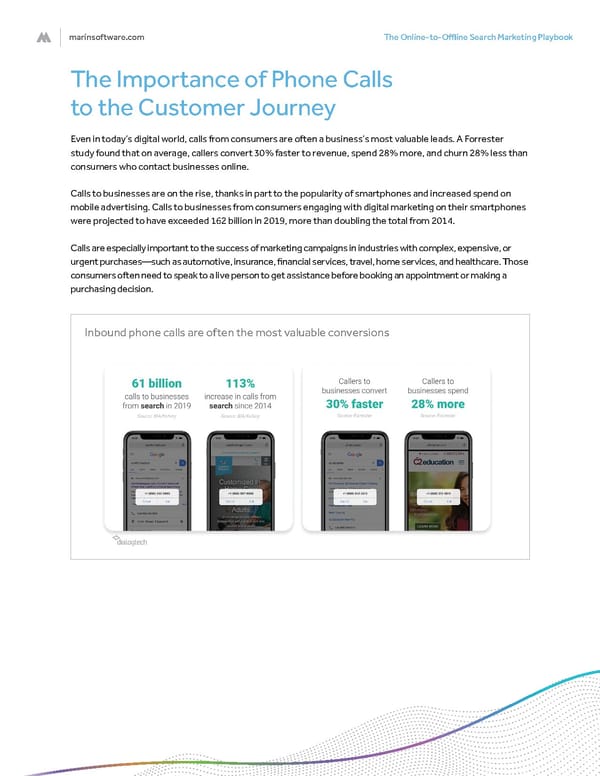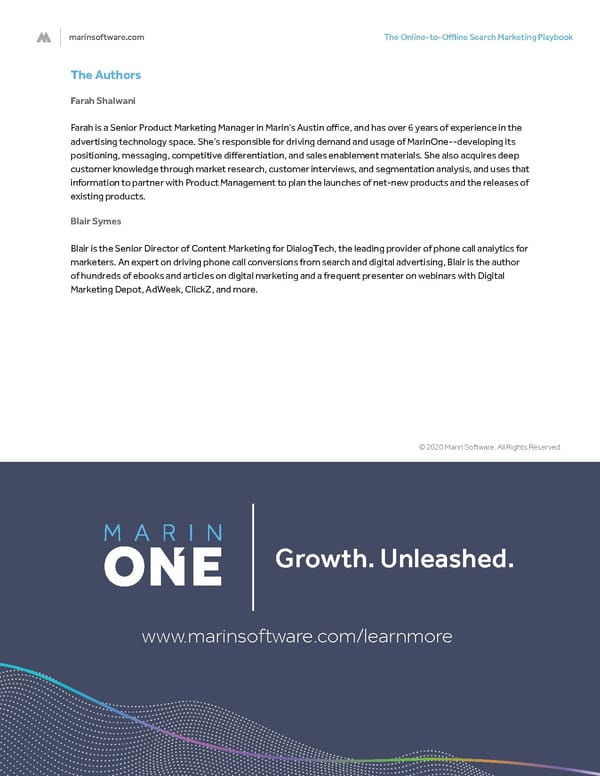Marin Software Demo
I N S S I E G R H I T E S The Online-to-Offline Search Marketing Playbook username 6min SALE 14 Likes usernameComment Like Comment
marinsoftware.com The Online-to-Offline Search Marketing Playbook Contents Better Visibility for Your Search Advertising Dollars ...............................................................3 Online Search Drives More Offline Sales .................................................................................4 Tactics for Growing Online-to-Offline Conversions...............................................................6 Create an ideal online-to-offline customer experience .....................................................................................................................6 Incorporate social media .......................................................................................................................................................................7 Localize your branded content .............................................................................................................................................................7 Remember that mobile’s influence on offline sales continues to grow ............................................................................................8 Different Ways to Track Online-to-Offline Conversions .........................................................9 Mobile Coupons .....................................................................................................................................................................................9 Store Visits .............................................................................................................................................................................................9 The Importance of Phone Calls to the Customer Journey ....................................................10 Get Actionable Insights from Calls with Conversation Intelligence ......................................12 Effective Inbound Call Strategies ...........................................................................................14 1. Incorporate Call and Location Extensions ..............................................................................................................................14 2. Make It Easy for People to Call You from Your Website ..........................................................................................................14 3. Accurately Report the Impact of Your Marketing on Business Results.................................................................................14 4. Drive Growth by Optimizing the Right Conversion Events ...................................................................................................15 5. Use Intelligence from Phone Conversations to Improve Audience Targeting .....................................................................16 6. Use Intelligence on the Call Experience to Detect and Correct Issues ................................................................................16 7. Use Data on the Caller to Personalize the Call Experience ....................................................................................................17 8. Optimize, Analyze, Repeat .......................................................................................................................................................18 Conclusion .............................................................................................................................19
marinsoftware.com The Online-to-Offline Search Marketing Playbook Better Visibility for Your Search Advertising Dollars Online marketers often struggle to find ways to measure and optimize the effectiveness of offline conversions from their search marketing campaigns. What do customers do after they leave their computers or smartphones, and how does that connect to their online journeys? In this white paper, we explore the importance of offline conversion their advancements in tracking; Indluding store visits and inbound phone calls. Our aim is to help companies with both large and brick-and-mortar footprints understand: • How Search Marketing Influences Offline Sales • Tactics for Growing Online-to-Offline Conversions • Store Visit Tracking • The Benefits of Tracking Calls for Marketing Campaigns • Leveraging Phone Conversations to Gain Insight for Smarter Marketing • Effective Inbound Call Strategies The ultimate goal is to directly tie search marketing to offline actions such as in-store visits, phone calls, and sales. By including offline data into your CRM, bid management, web analytics, and other marketing tools, you can get a holistic view of your buyer’s journey. Armed with this insight, you can then allocate budget and optimize campaigns to generate the greatest return on your investment and know which engagement tipped your customers towards a purchase.
marinsoftware.com The Online-to-Offline Search Marketing Playbook Online Search Drives More Offline Sales Search marketing influences decisions at every stage of the consumer’s journey. When people go from inspiration to purchase, they depend on search engines to find and research a product they’ll eventually buy. Consumers today are constantly shifting between shopping channels. That research period gives search advertisers a lot of leverage on the web, eventually driving incremental offline sales. According to Google, 30% of people who visit a website or app on their smartphone end up purchasing something in a physical store within 24 hours. In addition, 7 in 10 smartphone owners who make in-store purchases take relevant action on their phone prior to purchase. The actions people take to address their needs Search engine 40% Visited a retailer website or app 19% Visited another website or app 19% Visited a store or other location 15% Used a map 12% Looked at images or photos on a site or app 10% Asked someone via a call, 8% online messenger, or text message Watched an online video 6% Used social media 6% Connected with a business 6% In a separate report by eMarketer, some 90% of retail purchases are still made offline. While that share is set to steadily decrease, a radical shift won’t happen anytime soon—it’s forecasted that in 2023, 85% of retail purchases will still be made offline.
marinsoftware.com The Online-to-Offline Search Marketing Playbook US retail eCommerce sales, 2017-2022 billions % change and % of total retail sales $891.77 $787.15 $690.84 $604.18 $526.09 $454.91 16.3% 15.6% 14.8% 14.3% 13.9% 15.1% 9.0% 10.0% 11.1% 12.4% 13.7% 13.3% 2017 2018 2019 2020 2021 2022 Retail eCommerce sales % change % of total retail sales Source: www.eMarketer.com The same study echoed Google’s finding that roughly 1/3 of people research online, purchase in-store. Typical research and purchase process among US internet users, Jan 2018 % of responents 53% 48% Start researching digitally Start researching in-store 34% 19% 6% 42% Purchased Purchased Purchased Purchased digitally in-store digitally in-store Source: www.eMarketer.com
marinsoftware.com The Online-to-Offline Search Marketing Playbook Tactics for Growing Online-to-Offline Conversions Create an ideal online-to-offline customer experience You can use your customers’ behaviors and preferences to personalize their purchase journeys. Many retailers are starting to combine online and offline experiences, in that you can order a product and check if it’s available at a store near you for pickup. In many cases, even if it isn’t, you can still order and have it sent to your local store, ready to be picked up and free of shipping cost. username 6min SALE 14 Likes usernameComment Like Comment Similarly, online retailers are also toying with the idea of opening up physical stores at select locations for their customers who prefer to pick up the products themselves. Amazon opened its first cashierless grocery store in January 2018, also known as Amazon Go. If you have an Amazon app on your phone, you can simply walk into the store, pick up whatever items you want, and walk out without worrying about checking out. Amazon charges your account as soon as you leave and sends you a receipt. In a separate example, after noticing that many customers were coming into stores after a website or app visit with the names of frames scribbled on pieces of paper, Warby Parker created the ability to favorite items, with the information immediately accessible to store associates. This means that a store associate can easily input a user’s name and quickly pick out the frames they were interested in trying on, without much hassle to the potential customer. People were also trying on frames in their stores but they weren’t quite ready to check out. Warby Parker then created a way for associates to take pictures of customers wearing a favorite frame, turn it into a digital bookmark, and send to the customer via email. Both are creative ideas that save customers a ton of time.
marinsoftware.com The Online-to-Offline Search Marketing Playbook Incorporate social media Social media is a great way to generate awareness about your company’s products or services. expand your marketing efforts across other channels, and attract new buyers. Sharing images, posts, promotions, and other giveaways are great ways to garner more interest. And, the more you share, the more your followers will. This helps keep customers and prospects updated on your current events and latest offerings, and creates a strong bond with your customers, fostering a connection with you and your business. By responding to your customers’ concerns and asking for their opinions, you can enhance satisfaction while getting more traffic for your site, which further promotes in-store traffic for your brick-and-mortar business. Localize your branded content Location data gives advertisers the ability to tailor ads to respond to people’s unique experiences and behaviors—where they are and what’s happening in their world. Highly targeted audiences result in better ROI and more personalized ad experiences that make people feel like a business is speaking directly to them. In a study that Google conducted, it was found that two-thirds of smartphone users are more likely to purchase from companies with online content customized to their location. Building brand content that calls out the geographic locations of your business will lead to more engaged, higher-converting consumer interactions. of smartphone users are more likely 67% to purchase from companies whose mobile sites or apps customize information to their location. Source: Google / lpsos Connect, Jan. 2018, Playbook Omnibus 2018, n±1,604 us online smartphone users aged 18+. Location data isn’t just about delivering highly targeted ad experiences. It can also help retailers figure out how to better attribute revenue to the right marketing channel. After pushing an ad to a mobile device, advertisers can track whether a person actually visits a store by using location data that their mobile app provides. Some tips on how to localize your branded content include: • Mention specific locations in metadata, headlines, and body content. • Write unique, targeted content that provides information relevant to each location. • Use images specific to locations.
marinsoftware.com The Online-to-Offline Search Marketing Playbook Remember that mobile’s influence on offline sales continues to grow Lastly, don’t forget that device-level data is also very important. Having this data is especially valuable to businesses that rely heavily on eCommerce sales. In many cases, we find that while most consumers make purchases on desktop, most of the in-store visits come from people who first engaged from a mobile device. Search engines are making it easier for mobile users to quickly access the kind of information they’re typically looking for, from store locations and coupons to comparing prices and looking up product information. Because of this, it’s important to make both your website and content mobile-friendly.
marinsoftware.com The Online-to-Offline Search Marketing Playbook Different Ways to Track Online-to-Offline Conversions Knowing where your leads are coming from is just as important as reaching your acquisition goal at the end of the month. That’s how you’ll know which campaigns are giving better results and which ones are bringing in more sales opportunities. Here are a few different ways to track online-to-offline sales. Mobile Coupons If you’re advertising an exclusive offer online, you can display a different coupon code for each ad and source of traffic. So, if you’re advertising on hundreds of different keywords, then each one would have a different code to allow you to track sales back to the exact keyword. All you have to do is require that the customer give you the coupon code over the phone or in person to get the exclusive offer. Then, you can match the codes to the ads and sources of traffic. This method is pretty easy to implement and manage. It allows you the flexibility to track to a granular level, whether that’s to the online marketing channel or to a specific search keyword or display creative. Store Visits Some franchises invest time and money in 3rd-party analytics platforms that measure things like store visitors and POS transaction counts, and use the benchmarked data as a basis for predicting the lift you’ll get through your local search marketing strategies. Google’s version of this is Store Visits for Google Ads. It leverages signals that are based on aggregated anonymized data from users who’ve turned on their location history. The basic gist of Store Visits is that Google can match users’ search activity to their mobile device through their Google login; from there, GPS data can report when that person visited the advertiser’s physical location. This information is then compiled to estimate the total store visits from people who previously interacted with a digital ad.
marinsoftware.com The Online-to-Offline Search Marketing Playbook The Importance of Phone Calls to the Customer Journey Even in today’s digital world, calls from consumers are often a business’s most valuable leads. A Forrester study found that on average, callers convert 30% faster to revenue, spend 28% more, and churn 28% less than consumers who contact businesses online. Calls to businesses are on the rise, thanks in part to the popularity of smartphones and increased spend on mobile advertising. Calls to businesses from consumers engaging with digital marketing on their smartphones were projected to have exceeded 162 billion in 2019, more than doubling the total from 2014. Calls are especially important to the success of marketing campaigns in industries with complex, expensive, or urgent purchases—such as automotive, insurance, financial services, travel, home services, and healthcare. Those consumers often need to speak to a live person to get assistance before booking an appointment or making a purchasing decision. Inbound phone calls are often the most valuable conversions
marinsoftware.com The Online-to-Offline Search Marketing Playbook Search in particular—both organic and paid—is a huge generator of calls to businesses. That’s because most searches take place on smartphones, and tapping a click-to-call button in the search results page or on a business’s website is often the easiest and most immediate way for smartphone users to engage. Google says that mobile searchers are 39% more likely to call a business, while analyst firm BIA/Kelsey estimated that mobile searches drove nearly 61 billion calls to businesses in 2019. Percent of consumers who say they called after a search
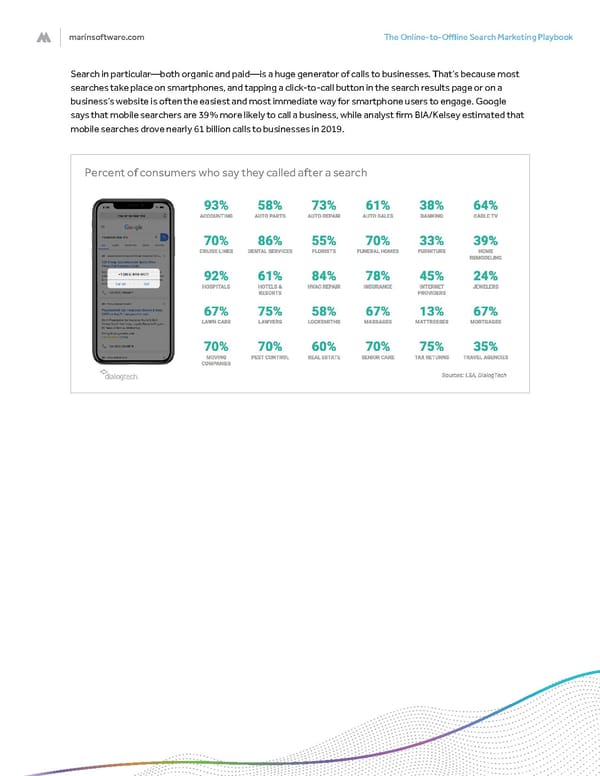
marinsoftware.com The Online-to-Offline Search Marketing Playbook Get Actionable Insights from Calls with Conversation Intelligence As a marketer, do you have visibility into the calls and caller experiences you generate from your search and digital ads, SEO, websites, and offline campaigns? Do you know what channels drive the most calls that convert to sales opportunities, appointments, bookings, or other purchases? Are you generating a large number of phone leads that aren’t translating to appointments or customers, and if so, do you know why? Common marketing challenges from calls from search When consumers call, brands and agencies can use intelligence from those phone conversations to improve their paid search campaign performance and generate more conversions at a lower CPL. The right conversation intelligence solution can help. A platform like DialogTech combines the attribution of call tracking with AI-driven conversation analytics to provide meaningful and actionable marketing insights from callers. It not only tells you what marketing source drove each call, who the caller is, and their location, it also closes the loop by analyzing the actual phone conversations to determine caller intent, lead score, product/service interest, conversion outcome, and more.
marinsoftware.com The Online-to-Offline Search Marketing Playbook Examples of insights AI provides marketers from phone conversations Those insights from phone conversations can then be integrated with the other tools in your marketing technlogy stack—including ad platforms like Google Ads and Facebook Ads Manager; CRMs like Salesforce; bid management solutions like Marin Software; web analytics tools like Google Analytics, and more. Using this full suite of tools, you can see the entire consumer journey and have the holistic data to optimize campaigns for the greatest return.
marinsoftware.com The Online-to-Offline Search Marketing Playbook Effective Inbound Call Strategies 1.Incorporate Call and Location Extensions With call and location extensions you can add phone numbers and addresses to ads and drastically increase CTRs. Searchers can tap a button to instantly place a direct call to your business or click to be sent directly to individual location pages on your website. This makes it fast and easy for people to call and find out more about your services and product offerings. Best practices when setting up call and location extensions include: • Set phone numbers to show only during times your business can take calls. • Set addresses to show online during times your business is open. • Use ad copy that incentivizes calls and visits. • When you’re using both call and location extensions on an ad, personalize display options so that what’s shown depends on the user’s device. • Use call extension bid adjustments to control how often your phone number appears with your search ads. 2.Make It Easy for People to Call You from Your Website A call to a business is a powerful indicator of strong purchasing intent. By adding phone numbers or call buttons to the most frequently visited parts of your website, you’re making it as easy as possible for people to place calls after finding you via search. This increases call conversions and gives people an opportunity to engage more deeply with your brand. 3.Accurately Report the Impact of Your Marketing on Business Results Marketers must constantly prove to stakeholders the impact their campaigns and spend are having on leads, sales opportunities, and revenue. And if your marketing and website generate phone calls, you need to include those calls and their outcomes in your reports. You can’t prove your true ROI or accurately forecast results of future marketing initiatives without it. For example, take Arbor Memorial, one of Canada’s largest cemetery and funeral service providers. Phone calls are an important step in their customer journey, so they use DialogTech to attribute calls generated by their marketing to their 150 locations. That attribution data on callers is integrated with their CRM system, connecting calls from marketing to customer acquisition. It enables Arbor Memorial to attribute 150% more revenue on average from their marketing spend than if they only attributed online conversions.
marinsoftware.com The Online-to-Offline Search Marketing Playbook Think about the reports you’re providing now to prove marketing ROI. How much better would the results be if you included all the calls you generate to your business? Optimize for the Keywords and Webpages Driving the Best Calls 4.Drive Growth by Optimizing the Right Conversion Events The most successful marketers aren’t interested in just generating website visits and calls—you want to drive appointments, sales opportunities, and revenue. Knowing what channels, campaigns, search keywords, and other marketing interactions generate the most customers—whether online or over the phone—at the lowest CPL enables you to invest in what really works best while eliminating spend on what doesn’t. The Better the Analytics on Calls, the Better the Optimizations
marinsoftware.com The Online-to-Offline Search Marketing Playbook Case Study: Pest Control Company Uses Marin and DialogTech to Drive More Profitable Conversions One of North America’s largest pest control companies uses search advertising to generate service appointments and customers. Besides attributing conversions made online, the company also uses DialogTech to measure the calls their paid search campaigns send to their contact center and 400 locations. They then pass data from DialogTech into Marin to optimize for the search ads, keywords, and days/times driving the most online requests and calls that converted to customers. By taking a data-driven approach to both online and call conversions, the pest control company saw that calls made directly from paid search call extensions drove twice the appointments than ones from landing pages. So they increased the volume of campaigns driving the most calls directly from search ads and layered in bid modifiers to help call extension show more frequently. This resulted in a 90% increase in calls from paid search ads. They also saw that their online scheduler on the landing pages had the highest conversion rate to sale and was the most profitable path, so they optimized landing pages to drive this path. As a result, overall profitability from paid search increased by 12%. 5.Use Intelligence from Phone Conversations to Improve Audience Targeting When consumers call your business, those conversations are a rich source of insights into that caller’s intent, urgency, product/service interest, and value. You can reduce your paid search CPL by using intelligence from those conversations to add callers to the most relevant audience segments. For example: • For unconverted callers whose conversation shows they’re good leads, retarget them with a special offer for the product/service they called about. Consider broadening your keyword list for them to ensure your ads are visible when they search, since you already know they’re the right type of lead. • For callers who converted to customers, put them into the most relevant upsell or cross-sell ad campaigns. You might also add them to lookalike campaigns to extend your reach and find new prospects resembling your best leads. • For callers whose conversations show they aren’t sales leads, add them to your exclusion lists so you don’t serve them ads that aren’t relevant. You don’t want to keep wasting budget retargeting a website visitor who called for customer support, to inquire about a job, or to solicit your business—it can really drive up your CPL fast. 6.Use Intelligence on the Call Experience to Detect and Correct Issues No matter how well you optimize your targeting, messaging, and bid strategies to generate more of the right type of caller, your ROI will suffer if your call centers or locations aren’t converting them to leads and customers. When it comes to the call experience, however, marketers may not even realize there’s a problem, even though there often is. A DialogTech study found that 1 in 5 calls from paid search go unanswered. That means that many callers that could be great leads are hanging up or being sent to voicemail, resulting in wasted ad spend.
marinsoftware.com The Online-to-Offline Search Marketing Playbook You can use conversation intelligence reports to see what percentage of calls from paid search to your business hang up or go to voicemail. You can then diagnose the reason why and make corrections to improve your ROI and reduce CPL. Understand How Well Locations & Call Centers Convert Callers For example, the marketing team at GE Appliances, one of the nation’s leading appliance repair providers, uses DialogTech to get insights into the caller experience their call center provides. By examining the data, they found that a high percentage of callers from paid search interacting with their call center’s IVR were abandoning their call prior to speaking with an agent. It turns out the IVR process was too long and confusing to navigate. When the marketing team realized this, they shortened the IVR, resulting in a rapid 50% decrease in abandoned calls (lost opportunities) and a 30% increase in sales leads, as callers were being connected with agents faster. 7.Use Data on the Caller to Personalize the Call Experience When consumers call, they expect to receive the right assistance right away. It’s important to connect them in conversation with the most appropriate agent or location immediately. Brands can use analytics on callers to automatically route them to the best location or agent to assist. These analytics include: • Channels, ads, search keywords, and webpages they called from • Their geographic location • Their stage of the customer journey • The day and time of the call How you decide the caller should be routed depends on your marketing and your business. But here are a few examples of how DialogTech customers are dynamically routing callers to convert more calls to customers.
marinsoftware.com The Online-to-Offline Search Marketing Playbook Prioritize Your Most Valuable Callers A larger insurance provider determined that consumers in certain ZIP Codes were responsible for more high- profile prospect calls, so the marketing team uses DialogTech to prioritize call routing based on the caller’s location. All calls go to their call center, but now they put callers from high-converting ZIP Codes into priority queues to get answered right away. After two months, they saw a 2% lift in sales from this call routing process, resulting in millions in additional revenue. In another example, one of North America’s largest retail brands uses the call channel to support their online store. If an online shopper begins the checkout process, but calls the retailer’s contact center before finalizing a purchase, the retailer has DialogTech route the caller directly to a live call center agent to assist. These callers receive the immediate assistance they need to complete the purchase. Route Calls from Leads vs. Customers Differently C2 Education, a leading tutoring and test prep provider, uses DialogTech to route calls dynamically to acquire more customers. To ensure their call center agents devote their time to converting new business, the marketing team has rules in place to only route new phone leads to the call center while sending calls from existing customers to the caller’s closest tutoring center location for help. It’s helped them increase enrollments from calls to the call center by 150%. 8.Optimize, Analyze, Repeat Once you start getting attribution and analytics on calls, you should measure performance and optimize your marketing for what drives the best results. You can then scale your effort for what’s bringing in the most customers—online and over the phone—while correcting issues that hurt your ROI. It’s a learning loop that can have a powerful impact on the effectiveness of your marketing. How to Use Online and Call Data Together to Optimize Results
marinsoftware.com The Online-to-Offline Search Marketing Playbook Conclusion Google and other search engines have a major influence on a customer’s purchase journey, so it’s important to create an ideal online-to-offline experience with the tactics discussed in this guide. Using data-driven insights on offline conversions—such as location data and conversation intelligence—will result in smarter budget allocation across your different channels. While attempting to measure and report on offline conversions and sales from your search and digital marketing efforts can seem like an overwhelming task, it doesn’t have to be. And the resulting impact it will have on results should justify the investment. As a reminder, Marin Software and DialogTech have a strong partnership that enables marketers to pass call data from DialogTech into their Marin Software platform and automatically allocate budget to the paid search keywords driving the most calls. If you’re an advertiser who drives sales opportunities, appointments, or orders via phone calls and are looking for a solution to help you optimize marketing spend to drive the most high-converting calls at the lowest cost, please reach out to either DialogTech or Marin Software to schedule a demo and learn more.
marinsoftware.com The Online-to-Offline Search Marketing Playbook The Authors Farah Shalwani Farah is a Senior Product Marketing Manager in Marin’s Austin office, and has over 6 years of experience in the advertising technology space. She’s responsible for driving demand and usage of MarinOne--developing its positioning, messaging, competitive differentiation, and sales enablement materials. She also acquires deep customer knowledge through market research, customer interviews, and segmentation analysis, and uses that information to partner with Product Management to plan the launches of net-new products and the releases of existing products. Blair Symes Blair is the Senior Director of Content Marketing for DialogTech, the leading provider of phone call analytics for marketers. An expert on driving phone call conversions from search and digital advertising, Blair is the author of hundreds of ebooks and articles on digital marketing and a frequent presenter on webinars with Digital Marketing Depot, AdWeek, ClickZ, and more. © 2020 Marin Software. All Rights Reserved. Growth. Unleashed. www.marinsoftware.com/learnmore 20

